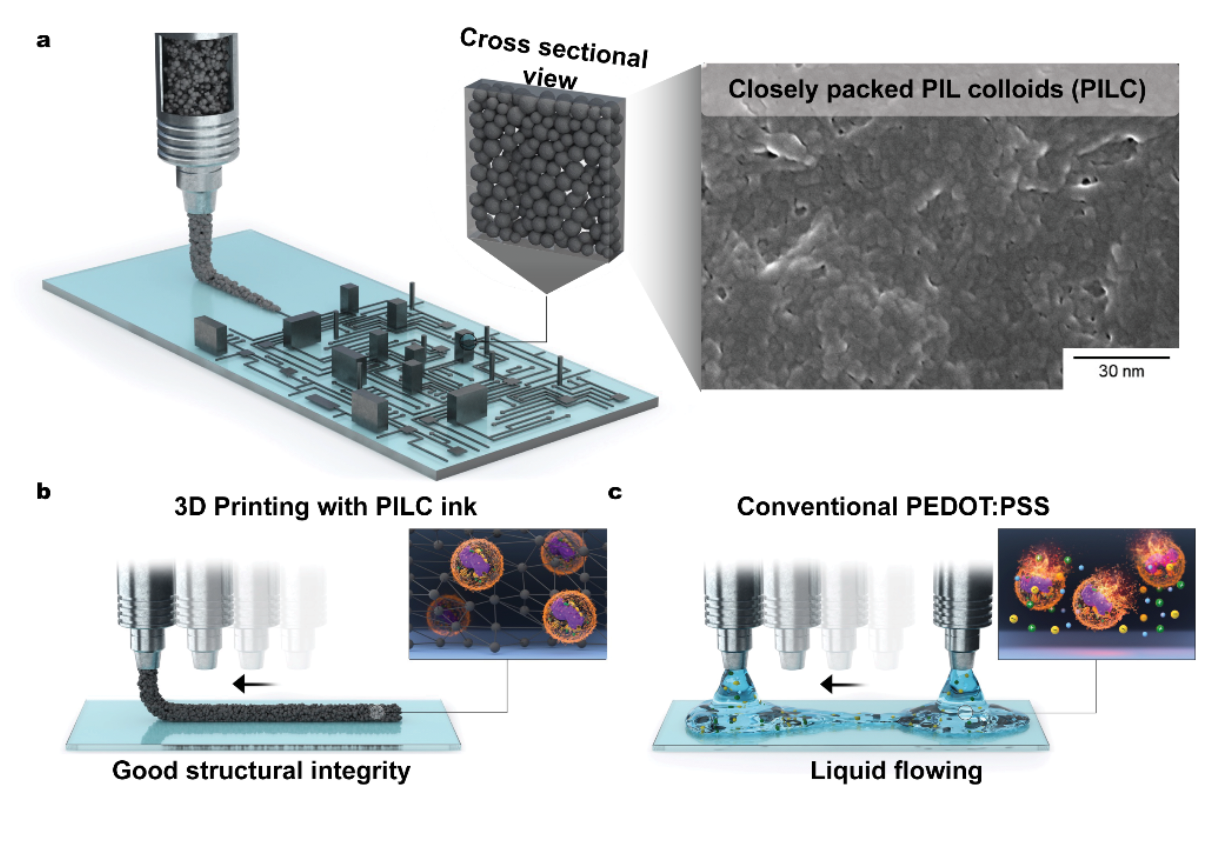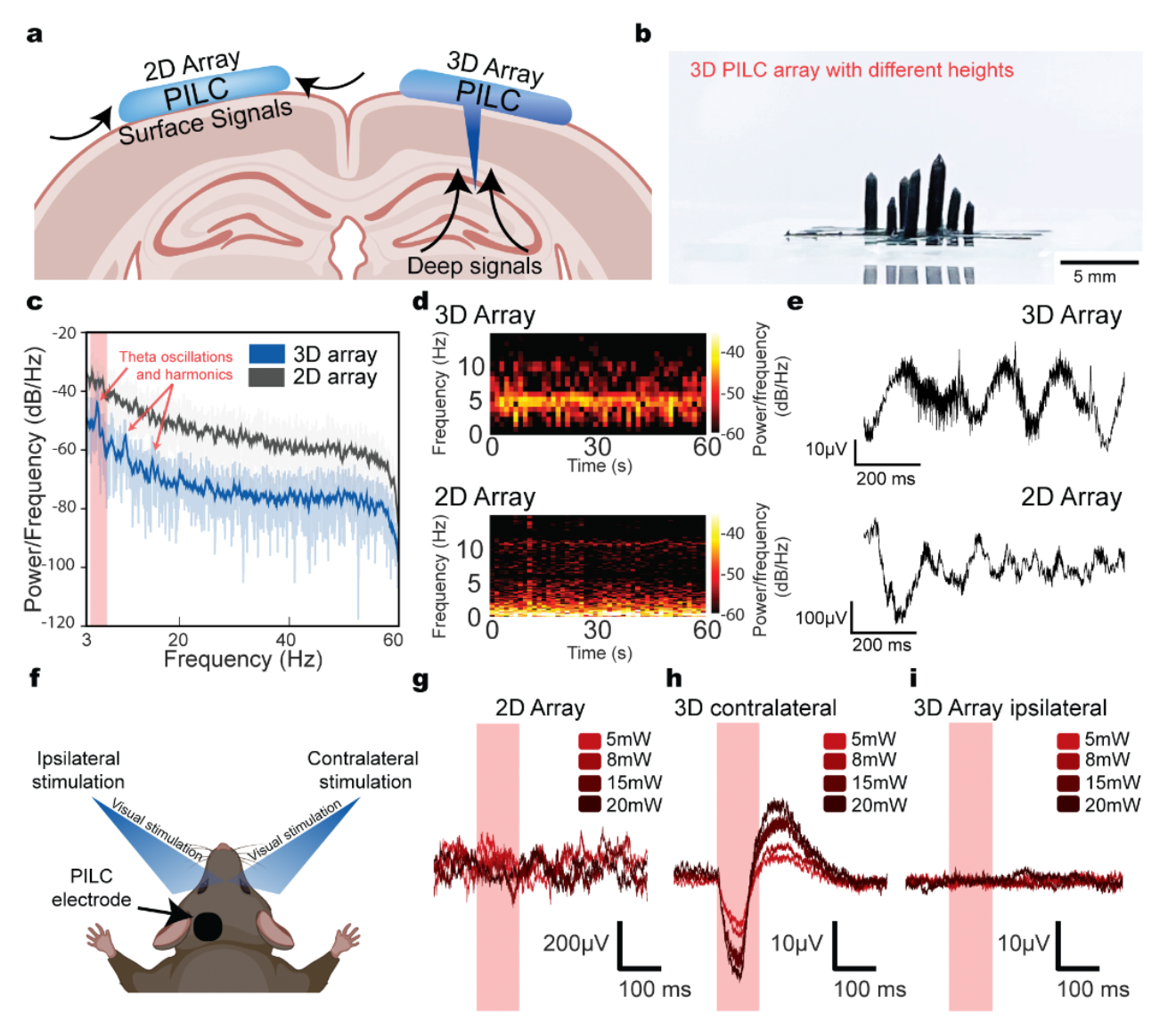Prof. Steve Park’s group at KAIST has developed a one-shot strategy to prepare biocompatible, highly conductive and 3D printable PEDOT:PSS-ionic liquid colloidal (PILC) inks for diverse bioelectronic interfaces without time-consuming post-treatment. This PEDOT:PSS colloidal ink allows on-demand rapid fabrication of bioelectronics that can be used in versatile bioelectronic applications from 2D in-vivo/ex-vivo electrodes and 3D diagonally printed circuit lines to 3D in-vivo electrodes.
In order to create a PEDOT:PSS ink with structural stability for tall 3D structures, we hypothesized that the dense packing of PEDOT:PSS colloidal particles on nanometer-length scales can induce higher rheological properties. To achieve this, an ionic liquid, EMIM:TCB (1-Ethyl-3-methylimidazolium tetracyanoborate), was used to obtain dense packing of PEDOT:PSS colloids in an aqueous solution (deionized water) with a centrifugal protocol. By using ionic liquid-facilitated PEDOT:PSS colloidal stacking and phase separation of residual cytotoxic ionic liquid induced by the centrifugal protocol, a viscoplastic PEDOT:PSS-ionic liquid colloidal ink was developed. The developed PEDOT:PSS-ionic liquid colloidal inks exhibit high-aspect ratio vertical stacking, omnidirectional printability for generating suspended architectures, high-resolution printing (~50 µm), high intrinsic conductivity (~286 S/cm), and intrinsic biocompatibility (cell viability: >92%) without any post-treatment. We demonstrate the on-demand and versatile applicability of PILC inks through the fabrication of 3D circuit boards, on-skin physiological signal monitoring e-tattoos, and implantable bioelectronics (opto-electrocorticography recording, low voltage sciatic nerve stimulation, and recording from deeper brain layers via 3D vertical spike arrays).
The versatile printing of the PEDOT:PSS-ionic liquid colloidal ink opens diverse applicability, ranging from complex and suspended 3D circuit boards and skin bioelectronics for healthcare monitoring to implantable bioelectronics with high customizability. The unique properties of the ink demonstrate its potential for use as a general purpose PEDOT:PSS ink compared to currently available 3D printing inks requiring lengthy post-treatment, which prevents immediate usage. The rapid on-demand fabrication of tissue-like PILC bioelectronics provides a platform to accelerate advancement in probing the body for future disease treatment. The study was published on July 11, 2024 (3D printable and biocompatible PEDOT:PSS-ionic liquid colloids with high conductivity for rapid on-demand fabrication of 3D bioelectronics, Nature Communications, 15, 5839, (2024)).
“Conventional 3D printable conducting materials require lengthy and complex post-processing steps to enhance conductivity and biocompatibility, limiting the full potential of 3D printing technology’s advantages in rapid prototyping,” said Steve Park, the corresponding author and a professor in the Department of Materials Science and Engineering and the KAIST Institute for the NanoCentury at KAIST. He added, “This study addresses these limitations, paving the way for future applications in patient-specific bioelectronic devices and various 3D circuit applications.”
This work was supported by the National Research Foundation (NRF) via the Creative Research Initiative Center (grant number: NRF-2021M3H4A1A03049075 and NRF-2022R1A2C2006076 to S. Park and grant No. 2022-0-00020 (Imperceptible on-skin sensor devices for musculoskeletal monitoring and rehabilitation).


Prof. Steve Park, Dr. Byungkook Oh Materials Science and Engineering (MSE), KAIST
E-mail: stevepark@kaist.ac.kr
Homepage: https://steveparklab.kaist.ac.kr






